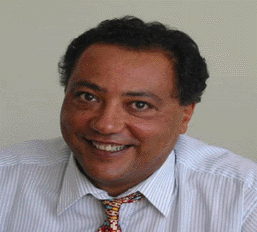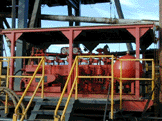 OIL AND MINES OIL AND MINES |
 Mines Mines |
Rubies, sapphires, emeralds, gold, graphite, chromite, quartz, iron, ilmenite, bauxite... Madagascar is a country with a strong mining potential. 240 million years ago, when oceans were formed, Madagascar that was then part of the same block as South Africa, detached itself. Unfortunately these treasures are under-exploited o badly exploited and only contribute to 3% of the GDP. Up to now Madagascar mostly exports industrial minerals such as chromite, mica, quartz and graphite. In 1998 exports reached USD 9 million. However, exports of precious stones are, in most cases, not declared and therefore are hard to estimate. Licenses granted represent 85% of small mines but they only contribute to 5% of mining tax earnings. Only 10% of export earnings come from mining. "Madagascar has a huge potential, but until now we have not contrived to manage it in a convenient way", recognizes Mr. Charles Rasoza, Minister of Mines and Energy.

MR. Charles Rasoza
Ministre de l'Energie et des Mines
The mining sector is timing with activities. Just for sapphire, corindon and ruby exploitation, 853 licenses were delivered. 704 operators presently work in mining operations, 219 in trade minerals and 216 in export mining products. But the exploitation of mineral deposits is often done by hand in an anarchic way, just like the sapphire, ruby and gold rushes of the past few years. Artificial and desorganized structures have been incorporated to villages otherwise scarcely composed of 10 or 20 houses, (Betsiaka, Daraina, Labeka, Ambondromifehy in the north and Andranodambo in the south).
Their reason to exist will certainly end once the mineral beds have been depleted. Thus, Ilakaka, a small town south of Madagascar, became a privileged destination of those who dream to make a fortune after the discovery of a sapphire bed in 1998. So even if small Malagasy miners are often disillusioned, for prospectors with the right material and foreign buyers, particularly European, African and Asian, it is quite a good deal.. The World Bank has started a project to regularize small mining developments. The Operations Director for the World Bank, Mr. Ghanem, underlines the problem mentioning that "buyers come directly to purchase to small miners and then they export illegally. One stone sold in Bangkok for USD 100 is acquired here for USD 5, because the added value of the cut, the polishing and the control of quality take place outside of Madagascar".
According to estimates, deposits would generate around USD 100 billion, or even more. Mining concessions will be granted via tenders in the reserved areas that will be established in time and space.It will also be possible to select those operators judged serious, to collect tariffs and taxes in advance, and to be environmentally cautious before starting operations. Since the deposits are not inexhaustible, the new mining code focuses on an optimal exploitation and thus tries to rationalize production and commercialization and to promote the flow of investments.

Mr Hafez Ghanem
Director of the World Bank for Indian Ocean | The law on large investments that will soon be passed to Parliament will regulate from now on investments above USD 250 million. It will not be anymore a case-by-case study, as it happened with Qit Madagascar Minerals (QMM) a Malagasy public stock company owned at 80% by a branch of Rio Tinto called Qit Fer (a British-Australian mining company) and 20% owned by the Malagasy government. This company has recently obtained an environmental license to exploit, in a first phase, a deposit of ilmenite from Mandena to Fort Dauphin. For 40-50 years, QMM will exploit the bed of mineral sands of Fort Dauphin containing 67 million tons of ilmenite.
.. Likewise, the American firm Phelps Dodge, that already did some exploration works between 1995 and 1998, pretends to exploit two mines of nickel in the region of Moramanga, in the RN2, in order to export the finished products under the shape of ingots. "Feasibility studies foresee 30,000 tons of nickel and 3,000 tons of cobalt per year. After giving it some thought we believe that we will need higher quantities for the exploitation to be profitable; around 40,000 tons of nickel and 4,000 tons of cobalt", explains Mr. Roger Scott, Director of Phelps Dodge Madagascar.
Madagascar has a promising mining potential. But in order to be able to attract investors, quality geological information has to be provided. This is not so obvious given the meager means of the Ministry and of the Office of National Mines and Strategic Industries (l'Office des Mines Nationales et des Industries Stratégiques - OMNIS). "Information is not sufficient to attract companies. For that reason we favor works in the field, but unfortunately we do not have the means" explains General Ackram. This year, thanks to the support of the French government, the Ministry of Energy and Mines has been able to make available to the public and mining operators a geological and mining information system.
 Oil Oil |
The dismantling of the national company, SOLIMA, that held the hydrocarbons monopoly on the island, has just been achieved under the supervision of the international community. 12 different lots have been allocated to the different buyers whether they were local or new comers to the market (refer to Privatization).

The Malagasy potential for hydrocarbons has always been in the agenda and numerous companies have succeeded each other in its search in the Big Island's soil with different degrees of success. Today, oil search is carried out by five oil companies, all of them based in Houston or Dallas: Gulfstream Resources Ltd., Triton Energy Inc., Hunt Oil company L.L.C., Xpronet and Vanco Energy Company Ltd. This proves how much, large operators, trust Madagascar's future in the oil and gas field. "Assessments are positive. All indexes are there, but we need to find oil. Indicators are positive and research will be carried out onshore and offshore" explains Général Mohajy Ackram, Directeur de l'Omnis.
|

